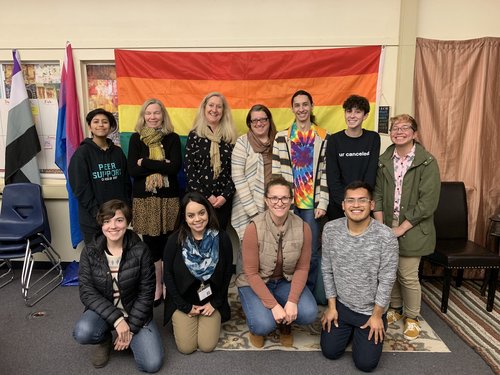Seven Strategies to Counter LGBTQ+ Youth Bullying
To counter LGBTQ+ youth bullying, raise awareness through education. Foster supportive peer networks to cultivate safe spaces. Implement anti-bullying policies with inclusive reporting mechanisms. Provide LGBTQ+ inclusive curriculum to promote acceptance. Offer mental health support to combat bullying. Encourage reporting and intervention against bullying behaviors. Engage LGBTQ+ youth in decision-making processes for effective solutions. Partner with LGBTQ+ organizations and allies. These strategies work together to create a supportive and inclusive environment for all.
Key Takeaways
- Educate on LGBTQ+ issues to raise awareness.
- Establish inclusive reporting mechanisms.
- Implement LGBTQ+ inclusive curriculum.
- Provide mental health support services.
- Empower youth through engagement and advocacy.
Raise Awareness Through Education

Educate school staff, students, and parents on the importance of recognizing and addressing LGBTQ+ youth bullying to create a safer and more inclusive environment.
Parental involvement plays a vital role in fostering understanding and support for LGBTQ+ youth. By providing resources and information to parents, you can create a network of allies within the community.
Community outreach programs can further amplify this message, reaching a broader audience and promoting acceptance.
Online safety is paramount in today’s digital age. Conduct allyship workshops to equip individuals with the knowledge and skills to stand up against bullying both in-person and online.
Empower students to be allies and create a culture of inclusivity within the school community. Encouraging open dialogue and promoting respect for all individuals regardless of their sexual orientation or gender identity is essential in combating LGBTQ+ youth bullying.
Through education and awareness, you can make a significant impact in creating a safer and more supportive environment for all students.
Foster Supportive Peer Networks

To cultivate a supportive environment for LGBTQ+ youth and combat bullying, fostering networks of peers who offer understanding and acceptance is essential. Peer support plays a vital role in creating safe spaces for LGBTQ+ individuals.
Encouraging the formation of friendship circles where everyone feels included and respected can greatly impact the well-being of LGBTQ+ youth. These supportive networks provide a sense of belonging and validation, helping individuals navigate the challenges they may face due to their sexual orientation or gender identity.
Acceptance within peer groups not only fosters a sense of community but also acts as a shield against bullying and discrimination. When LGBTQ+ youth have friends who support and stand up for them, they’re more likely to feel empowered and confident in their identities.
Implement Comprehensive Anti-Bullying Policies
You can make a significant impact by actively participating in the policy development process, ensuring that the needs of LGBTQ+ youth are at the forefront.
It’s essential to advocate for inclusive reporting mechanisms that provide a safe space for victims to come forward without fear of retaliation.
Additionally, supporting staff training programs to recognize and address LGBTQ+ youth bullying is key to creating a more inclusive and accepting environment.
Policy Development Process
By giving priority to the implementation of thorough anti-bullying policies, you can create a safer and more inclusive environment for LGBTQ+ youth. Involving the community in the policy development process is vital to guarantee that the needs and concerns of LGBTQ+ youth are effectively addressed. When it comes to policy implementation, it’s important to have clear guidelines in place that explicitly prohibit bullying based on sexual orientation or gender identity.
Community involvement in policy development ensures that a diverse range of perspectives are considered, leading to more thorough and effective anti-bullying measures. By actively engaging with LGBTQ+ organizations, educators, parents, and students, you can create policies that aren’t only inclusive but also reflective of the community’s values and expectations.
When implementing anti-bullying policies, it’s crucial to provide training for staff members on recognizing and addressing LGBTQ+ youth bullying. Regularly reviewing and updating these policies based on feedback and evolving best practices is vital to maintaining a safe and supportive environment for all students.
Inclusive Reporting Mechanisms
Establishing inclusive reporting mechanisms within comprehensive anti-bullying policies is essential to ensuring that LGBTQ+ youth feel safe and supported in their school environments. Creating safe spaces where students can report incidents anonymously is pivotal. This anonymity can help protect the identity of the reporter, especially in cases where they may fear retaliation or stigma.
In addition to anonymous reporting, providing avenues for peer support is imperative. Encouraging students to look out for one another and offering resources for intervention training can empower them to step in when they witness bullying behavior. Peer support can create a sense of community and solidarity among LGBTQ+ youth, fostering a culture of inclusivity and mutual respect.
Staff Training Programs
To effectively combat LGBTQ+ youth bullying, ensuring that staff are equipped with the necessary knowledge and skills through thorough training programs on anti-bullying policies is paramount.
Interactive workshops can provide a platform for staff to engage actively in learning about LGBTQ+ issues, understanding different forms of bullying, and practicing intervention strategies. Role-playing scenarios during these workshops can help simulate real-life situations, preparing staff to respond effectively and empathetically.
Moreover, ongoing coaching sessions can offer continuous support and guidance to staff members, reinforcing their understanding of anti-bullying policies and LGBTQ+ inclusivity. Evaluation techniques should be implemented to assess the effectiveness of the training programs, allowing for adjustments and improvements to be made where necessary.
Provide LGBTQ+ Inclusive Curriculum
When it comes to countering LGBTQ+ youth bullying, providing an inclusive curriculum is essential.
By incorporating diverse content, including LGBTQ+ representation, you create a more inclusive learning environment where all students feel seen and valued.
Recognizing the importance of LGBTQ+ inclusion in curriculum helps foster empathy, understanding, and respect among students of all identities.

Curriculum Content Diversity
Incorporate LGBTQ+ inclusive content into educational materials to promote diversity and acceptance among students. Representation in textbooks is essential as it allows LGBTQ+ youth to see themselves reflected positively in their learning materials.
Including diverse perspectives and experiences in classroom discussions helps create a more inclusive environment where all students feel valued and respected.
By integrating LGBTQ+ history, literature, and contributions across various subjects, you can foster a deeper understanding and empathy among students. This not only benefits LGBTQ+ youth but also educates all students on the importance of acceptance and diversity.
When students engage with LGBTQ+ content, they’re more likely to develop a broader worldview and cultivate a culture of respect.
Embracing LGBTQ+ inclusive curriculum content is a powerful way to challenge stereotypes, combat discrimination, and create a more inclusive school community. It sends a clear message that diversity isn’t only accepted but celebrated, fostering a supportive environment for all students to thrive.
LGBTQ+ Representation Importance
Diversifying educational materials by incorporating LGBTQ+ inclusive content is vital for promoting acceptance and fostering a supportive learning environment for all students. Media representation plays an important role in shaping attitudes and beliefs.
When LGBTQ+ individuals are portrayed positively and authentically in educational materials, it enhances LGBTQ+ visibility, helping students see themselves reflected in the curriculum. This representation isn’t just about statistics or history; it’s about showing LGBTQ+ individuals in all their diversity and complexity, validating their experiences and identities.
In school environments, LGBTQ+ acceptance can be greatly influenced by the inclusivity of the curriculum. By including LGBTQ+ perspectives across various subjects, students gain a more thorough understanding of different identities and experiences. This inclusive approach cultivates empathy, respect, and appreciation for diversity among all students.
It creates a space where LGBTQ+ individuals feel acknowledged and supported, contributing to a more inclusive and equitable learning environment for everyone.
Promote Mental Health Resources
Encourage LGBTQ+ youth to access and utilize mental health resources as an essential support in combating bullying and promoting their well-being.
Mental health awareness and community support play pivotal roles in helping LGBTQ+ individuals navigate the challenges they may face due to bullying.
LGBTQ+ counseling and crisis intervention services are tailored to address the specific needs and experiences of this community, providing a safe space to express emotions and seek guidance.
Encourage Reporting and Intervention
To help create a safer environment for LGBTQ+ youth and address instances of bullying effectively, fostering a culture where reporting and intervention are encouraged is essential. Supportive interventions and reporting encouragement play an important role in combating LGBTQ+ youth bullying.
Encouraging individuals to speak up when they witness or experience bullying behavior is fundamental in creating a community where everyone feels safe and supported.
Implementing intervention strategies and reporting initiatives can empower LGBTQ+ youth to take action against bullying. It’s necessary to provide clear channels for reporting incidents, ensuring confidentiality and swift responses to such reports.
Engage LGBTQ+ Youth in Decision-Making

Incorporating LGBTQ+ youth in decision-making processes fosters empowerment and enhances the inclusivity of initiatives aimed at addressing bullying within the community. When LGBTQ+ youth have the opportunity to participate in decision-making, their voices are heard, and their perspectives are valued. This involvement not only empowers them but also leads to more effective and sustainable solutions to combat bullying.
Youth empowerment through decision-making allows LGBTQ+ individuals to advocate for themselves and their peers. By actively engaging in leadership roles, these young individuals can shape policies and programs that directly impact their lives. This active participation fosters a sense of ownership and responsibility, creating a more supportive and inclusive environment for LGBTQ+ youth.
When LGBTQ+ youth are involved in decision-making processes, they bring unique insights and experiences to the table. Their input can lead to more holistic strategies that address the root causes of bullying and promote a culture of acceptance and respect. By fostering a culture of inclusivity and collaboration, organizations can create a safer and more supportive space for LGBTQ+ youth to thrive.
Partner With Lgbtq+ Organizations and Allies
Collaborating with LGBTQ+ organizations and allies can greatly enhance your efforts to create a more supportive and inclusive environment for LGBTQ+ youth. By forming community partnerships and engaging in advocacy efforts with these organizations, you can tap into a wealth of knowledge and resources that can help combat LGBTQ+ youth bullying effectively.
Supportive allies within LGBTQ+ organizations can provide valuable insights and perspectives on the challenges faced by LGBTQ+ youth. They can also offer guidance on best practices for creating safe spaces and implementing anti-bullying initiatives.
Additionally, through resource sharing, you can access educational materials, training programs, and support networks that can strengthen your efforts to support LGBTQ+ youth.
Partnering with LGBTQ+ organizations and allies not only amplifies your impact but also sends a powerful message of solidarity and inclusivity. Together, we can work towards creating a more accepting and affirming environment for all LGBTQ+ youth.
Frequently Asked Questions
How Can Parents Address Lgbtq+ Youth Bullying at Home?
To address LGBTQ+ youth bullying at home, start by fostering family support. Encourage open communication, involve the community for a safe network, and prioritize mental health support. Together, you can create a nurturing environment that promotes acceptance and understanding.
Are There Specific Legal Protections for Lgbtq+ Students?
Yes, there are legal rights and discrimination protections in place for LGBTQ+ students. These laws safeguard against discrimination based on sexual orientation or gender identity. It’s important to be aware of and make use of these protections to guarantee a safe educational environment.
What Role Can Teachers Play in Supporting Lgbtq+ Youth?
As a teacher, you can make a difference by undergoing LGBTQ+ sensitivity training, advocating for inclusive policies, fostering community support, and implementing an inclusive curriculum. Your support can create a safe and accepting environment for LGBTQ+ youth.
How Can Schools Address Cyberbullying Targeting Lgbtq+ Students?
To address cyberbullying targeting LGBTQ+ students, focus on online safety measures like reporting tools and digital citizenship education. Incorporate an inclusive curriculum that promotes diversity and respect. By creating a supportive online environment, you can combat this harmful behavior effectively.
What Resources Are Available for Lgbtq+ Youth in Rural Areas?
In rural areas, LGBTQ+ youth can access support through community centers, hotlines, online forums, and local support groups. These resources provide safe spaces, guidance, and connections to help you navigate challenges and find acceptance.
Conclusion
To sum up, by implementing these seven strategies, you can help create a safer and more inclusive environment for LGBTQ+ youth. Together, we can raise awareness, provide support, and advocate for change.
Remember, every action, no matter how small, makes a difference in the fight against bullying. Let’s work together to guarantee that all young people feel accepted, valued, and respected for who they are.
You have the power to make a positive impact in the lives of LGBTQ+ youth.

Hey there! 👋 I’m a proud mom and passionate writer, sharing my parenting journey. 📝 Join me as I navigate the ups and downs of motherhood, offering tips, advice, and a sprinkle of humor along the way. 🌟






